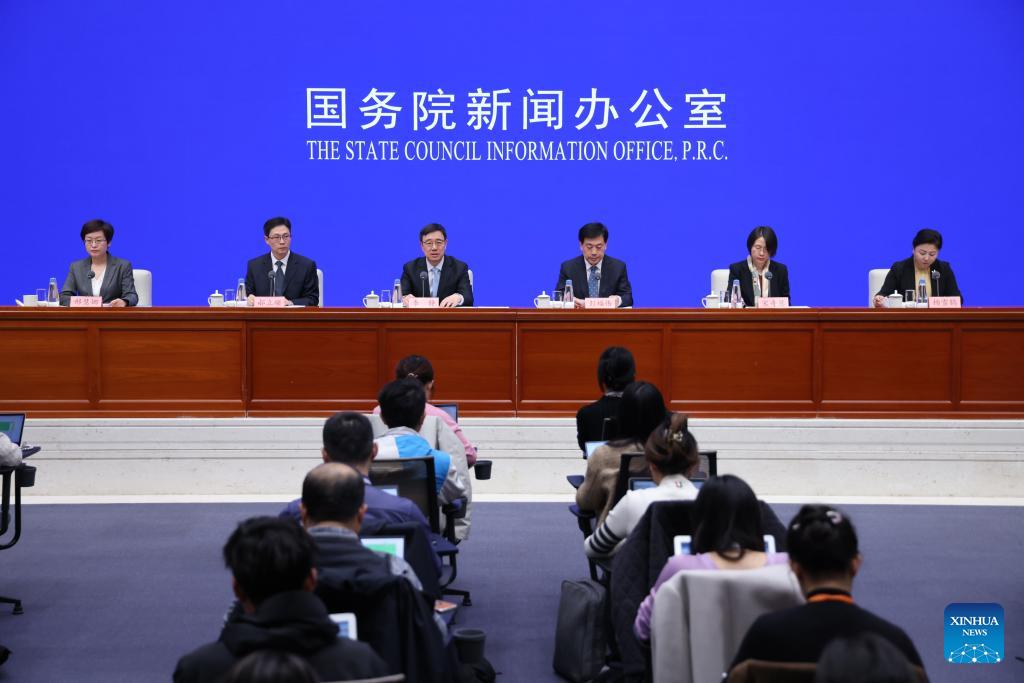Xinhua | November 7, 2024

A briefing on policy measures for stimulating the vitality of the ice and snow economy through the high-quality development of winter sports is held by the State Council Information Office in Beijing, capital of China, Nov. 6, 2024.(Xinhua/Jin Liwang)
China aims to promote its ice and snow economy as a new growth point, with the goal of reaching an economic scale of 1.2 trillion yuan (about 169 billion U.S. dollars) by 2027, according to the guidelines issued by the General Office of the State Council.
By 2027, the facilities for ice and snow sports will be more complete, the service level will be significantly improved, ice and snow sports will be carried out more widely, and China's international competitiveness in these sports will be further enhanced, according to the guidelines published Wednesday.
By 2030, the role of the ice and snow economy in expanding employment and promoting high-quality development will become more prominent, and ice and snow sports consumption will become an important growth point for expanding domestic demand.
The scale of the ice and snow economy is expected to reach 1.5 trillion yuan by 2030, the guidelines said.
In the following years, China will adopt a slew of measures to boost the development of the ice and snow economy, including promoting ice and snow sports, improving infrastructure and supporting services, cultivating business entities in the sector, and deepening international cooperation, among others.
IMPORTANT DOCUMENT
At a press conference on the publicized guidelines, Li Jing, deputy head of China's General Administration of Sport, said the guidelines were an important document issued after the 2022 Beijing Winter Olympics and Paralympics, adding that the guidelines were of great significance to promoting the development of the ice and snow sports and economy.
"The guidelines correspond to the needs of the people to participate in more diversified ice and snow sports, and will help promote the ice and snow economy to become a new growth point," said Peng Fuwei, head of the Department of Social Development under the National Development and Reform Commission.
Peng said that since China successfully hosted the Beijing Winter Olympic and Paralympic Games, ice and snow sports have driven the rapid development of tourism, competition performances, sports training and equipment manufacturing, with the ice and snow economy as a whole showing a strong development momentum.
In this context, the latest guidelines are expected to further consolidate these achievements by attracting more people to participate in ice and snow sports in the coming years, Peng said.
Li Jing underscored several policy highlights of the guidelines, which said that the number of tickets available for snow and ice events should be increased to enhance the experience of the public in watching and participating in events. The guidelines proposed establishing ice and snow sports schools, and supporting qualified colleges and vocational schools in setting up sports and economy majors related to ice and snow.
Financial institutions are encouraged to innovate financial products by increasing credit support for enterprises in the sector by optimizing related procedures such as credit rating and loan approval. Eligible enterprises in the sector will be supported in their plans to go public, refinance, issue bonds and securitize assets.
According to Li, the guidelines also proposed that land for ice and snow projects should be ensured in annually-planed new construction land in order to increase the supply of land for snow and ice venues and facilities.
BOOMING TOURISM, MANUFACTURING
Song Qihui, an official with the Ministry of Culture and Tourism, said at the press conference that ice and snow tourism has been growing since the Beijing Winter Olympics, with many destinations in northern China attracting large numbers of visitors. For instance, ice skating at Shichahai lake in Beijing, winter Naadam featuring off-road racing on snow in Inner Mongolia Autonomous Region, Chagan Lake winter fishing in Jilin, and fur skiing in Xinjiang's Altay are quite popular with tourists.
"Especially since last winter, the popularity of the city of Harbin (capital of northeast China's Heilongjiang Province) has driven the development of local catering, accommodation, entertainment, shopping and other related industries," the official said.
In the 2023-2024 snow season, Harbin received more than 87 million tourists, up 300 percent year on year. In the same period, it achieved a tourism income of 124.8 billion yuan, up 500 percent, Song said.
Across the country, the number of ice and snow tourists increased by 38 percent year on year during the last snow season, and revenues increased by 50 percent, said Song, citing data from the China Tourism Academy.
The industrial scale of ice and snow equipment manufacturing in China has grown quickly in recent years, with the country at present able to provide 15 major categories of ice and snow equipment products that cater to the needs of individuals, business venues, competition events, and mass sports, according to Hao Lishun, an official with the Ministry of Industry and Information Technology.
Data from the ministry shows that ice and snow equipment enterprises in the country have grown from around 300 in 2015 to around 900 in 2023, while their sales revenues also grew from less than 5 billion yuan in 2015 to around 22 billion yuan in 2023.



